MARIANI’S
Virtual Gourmet
October
28, 2018
NEWSLETTER
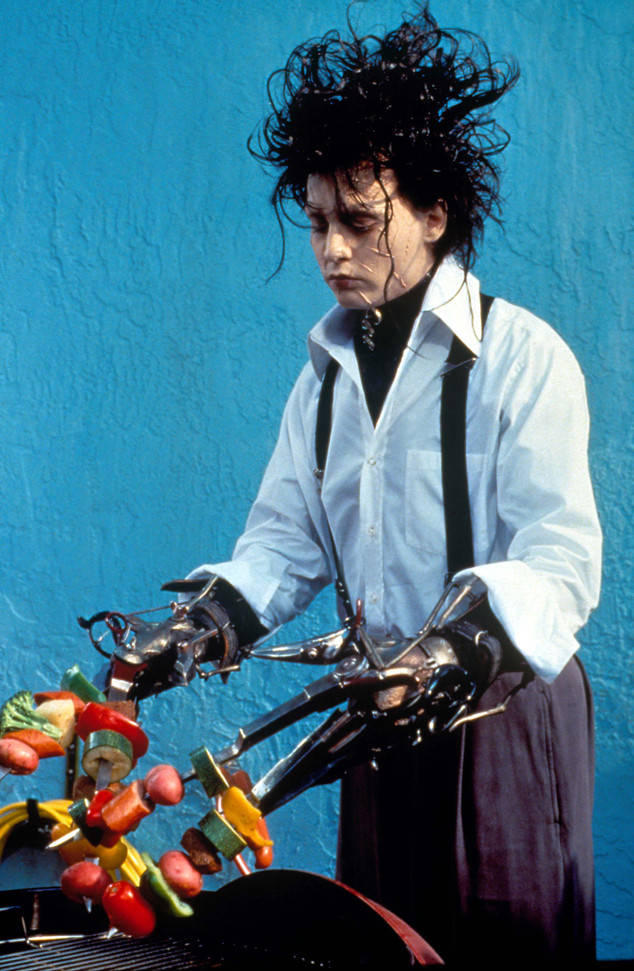
❖❖❖
IN THIS ISSUE
MIAMI, Part One
By John Mariani
NEW YORK CORNER
BLACKBARN CAFÉ
By John Mariani
NOTES FROM THE WINE CELLAR
THE GOLDILOCKS DILEMMA
By John Mariani
❖❖❖
MIAMI
Part One
By John Mariani
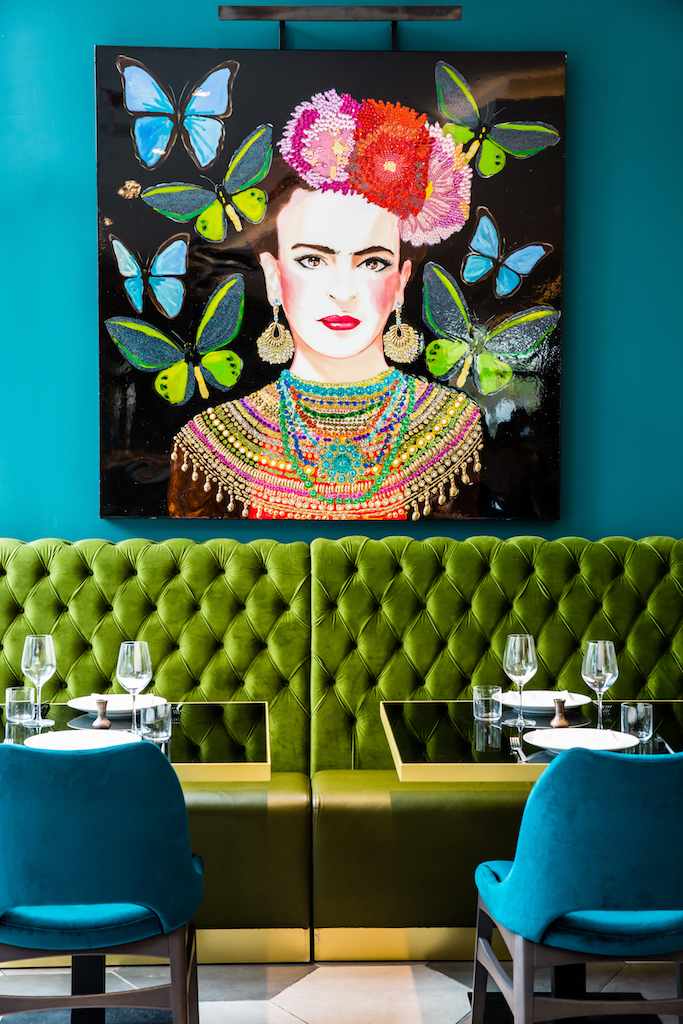
Three Restaurant
Finding good restaurants on Miami Beach isn’t easy, and a lot of the real excitement is on the Mainland, particularly around Wynwood and downtown. Curiously enough, modern Cuban restaurants are almost impossible to find outside Calle Ocho, but the best new restaurants take full advantage of the bounty of farms and sea that surround the city.
OBRA KITCHEN TABLE
1331 Brickell Bay
Drive
305-846-9396
Photos by Miami Chefs
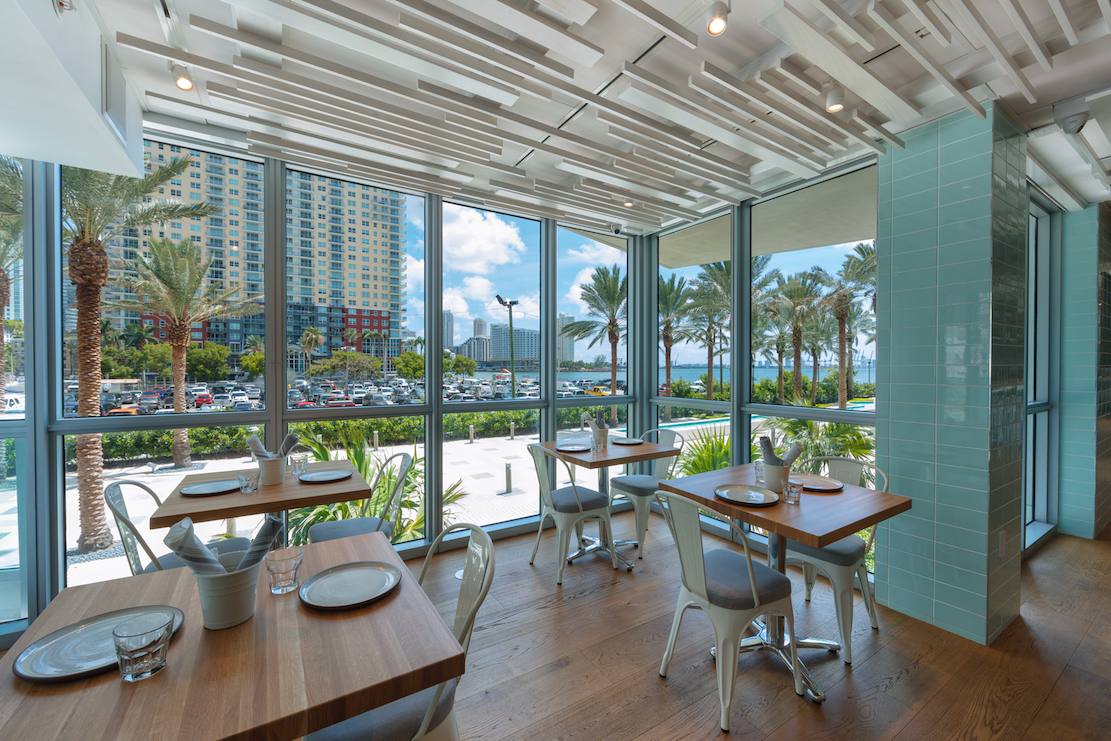 The
best new restaurant—opened last spring—I found
downtown was happily very much in the Latin style,
though not Cuban, and looked it. With its wide
expanse of windows overlooking Biscayne Bay and
its subtle modulations of white and light blues,
the room seems to be floating on water and the
dishes arrive looking like sea anemones or
floating flowers.
The
best new restaurant—opened last spring—I found
downtown was happily very much in the Latin style,
though not Cuban, and looked it. With its wide
expanse of windows overlooking Biscayne Bay and
its subtle modulations of white and light blues,
the room seems to be floating on water and the
dishes arrive looking like sea anemones or
floating flowers.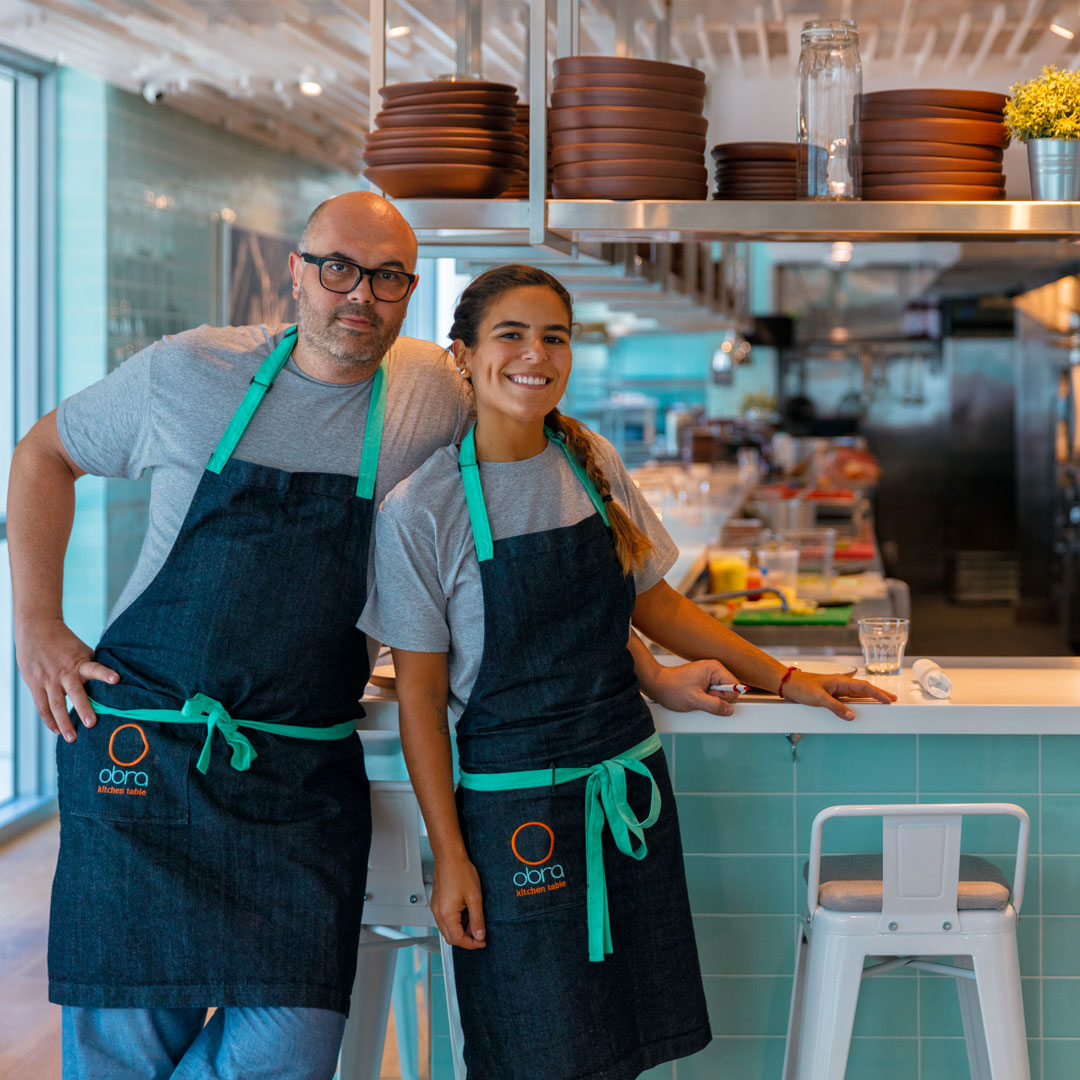
Carlos Garcia is proudly
Venezuelan, as is his sous-chef, Estafania Andrade (who is only
23), and just about everything I tasted was
teeming with their personalities. You can
tell when a chef creates a dish he wants his
guests to love, not just admire, and the color and
presentations are simply gorgeous.
My meal began with something
called “Vuelve
à la vide” ($12), which means “return to life”
after a hard night of revelry. It’s often the name
of a soup but here it is a shrimp escabeche with
avocado and crisp shredded chicken arepas called
“reina
pepiada,”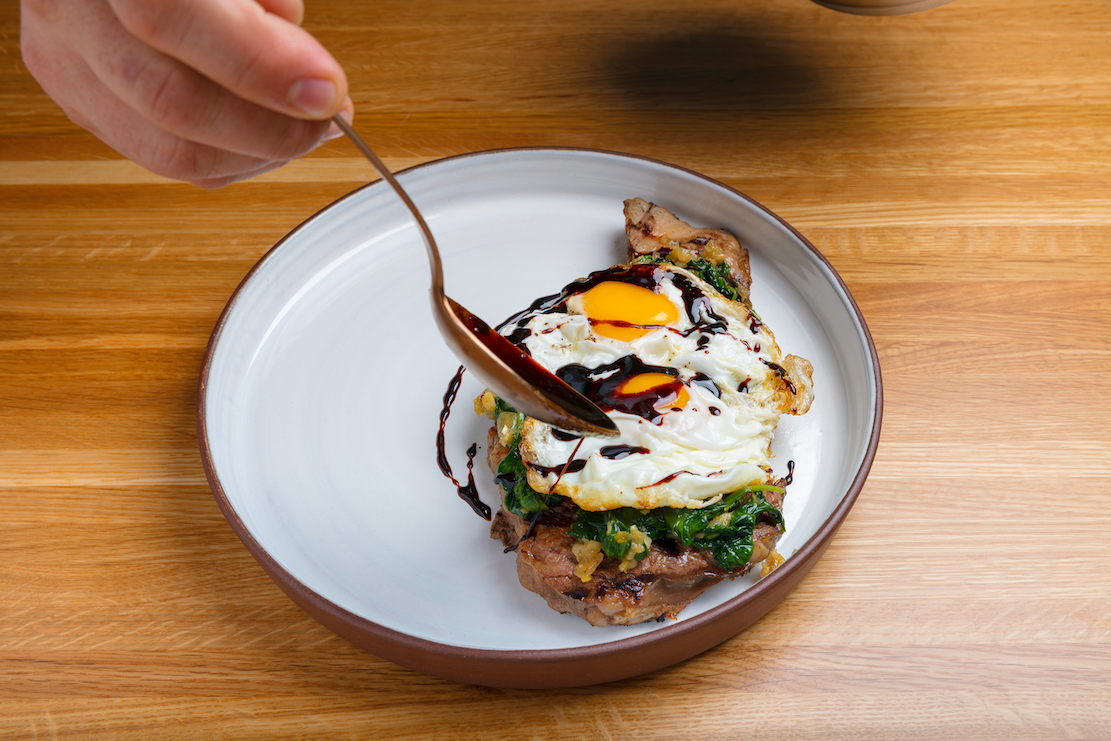 named after Venezuelan Susana Dujim, who was Miss
Universe in 1955. Yellowtail kingfish of exacting
freshness was served in the Peruvian tiradito
sushi style ($17), with pineapple-flavored rum and
a soffrito
paste with crispy kale. Of so many favorites on
the menu I was bowled over by a millefeuille of
yuca and bacon with sautéed foie gras ($37) of
very fine quality.
named after Venezuelan Susana Dujim, who was Miss
Universe in 1955. Yellowtail kingfish of exacting
freshness was served in the Peruvian tiradito
sushi style ($17), with pineapple-flavored rum and
a soffrito
paste with crispy kale. Of so many favorites on
the menu I was bowled over by a millefeuille of
yuca and bacon with sautéed foie gras ($37) of
very fine quality.
There is a section of pasta and
rice that includes a wonderfully al dente corn
and avocado risotto ($22). Among
the seafood was a grouper confit ($32.), similar
to a Spanish pil-pil’s
creaminess, with a fried arepa.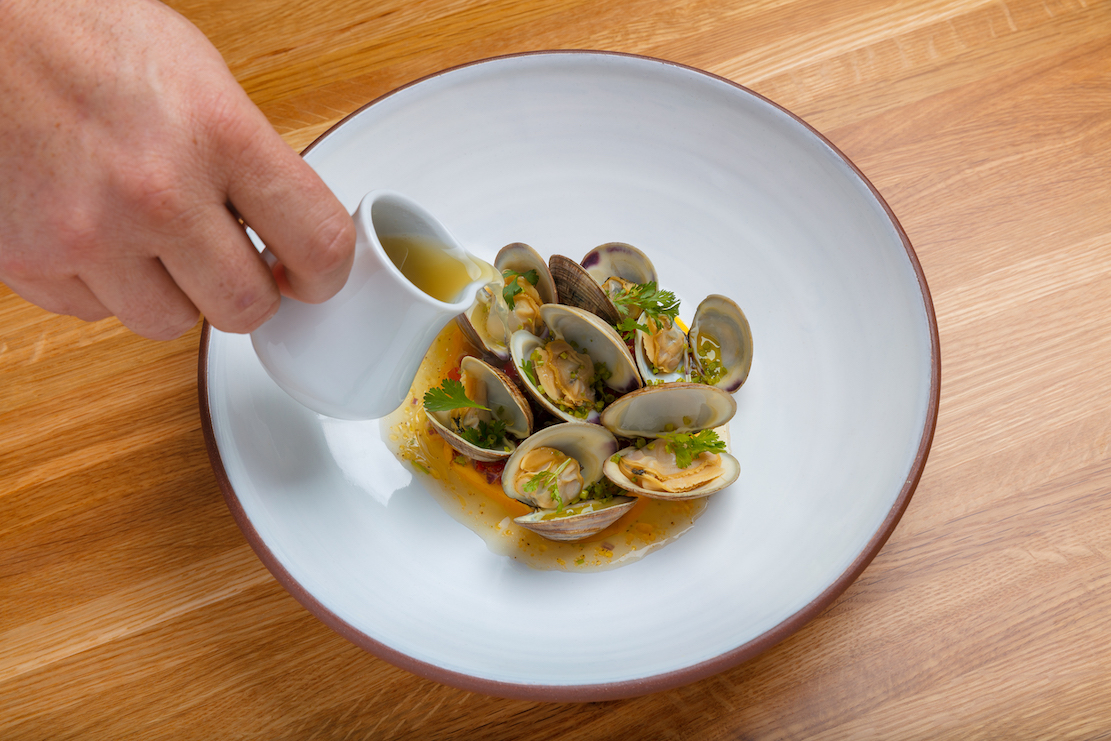
By now you can readily see
that there’s nothing predictable on Obra’s menu,
including a generous dish both luscious and homey
of bone marrow and a traditional Venezuelan stew
($30). Dessert was a Venezuelan
flan called quesillo
($12).
If you're going to Miami this
season, Obra is not to be missed.
THREE
50
NW 24th Street
302-748-4540
Photos by Open I
Studio
Most
of those Miami chefs who created the so-called
“New Floridian (or Floribbean) Cuisine” have
either decamped or 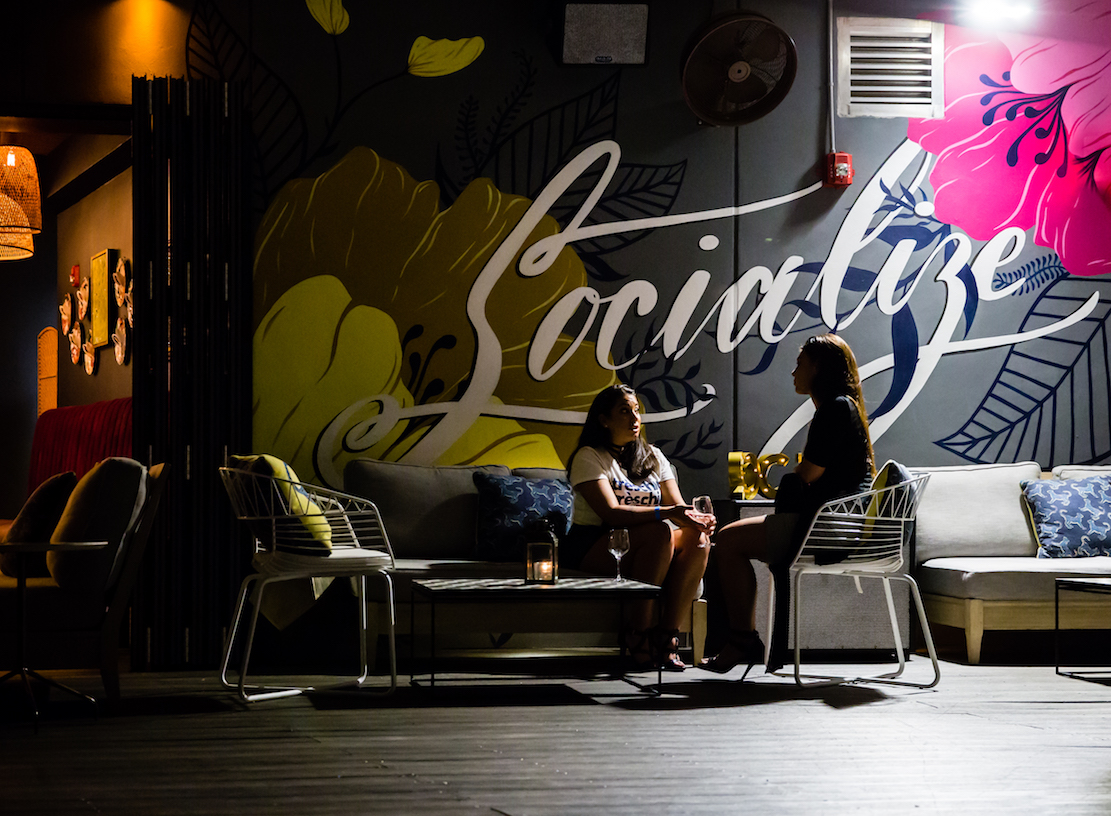 abandoned
the genre they made famous. One who
has not is Norman Van Aken (left), who
first distinguished himself back in the ‘80s at
Louie's Back Porch in Key West, then went on to
open a series of restaurants that still show why
he is one of the region’s most innovative and
respected chefs. (He’s also a first-rate harmonica
player.)
abandoned
the genre they made famous. One who
has not is Norman Van Aken (left), who
first distinguished himself back in the ‘80s at
Louie's Back Porch in Key West, then went on to
open a series of restaurants that still show why
he is one of the region’s most innovative and
respected chefs. (He’s also a first-rate harmonica
player.)
The name of the
restaurant, set within Wynwood Arcade, has several
connotations: There are three principal partners
and three “endeavors”—the Cooking School (below, right), the
Rooftop No. 3 Social cocktail lounge (right) and
The Restaurant—and three is a sacred number “representative of past, present
and future and is considered the number of
harmony, wisdom and understanding.” Whatever.
That Rooftop starts thumping
after nine o’clock, but the dining room below is a
far more sophisticated and glowingly lighted
space, with an open kitchen and counter.
Van Aken and Chef de Cuisine
Juan Garrido are doing a dazzling job of showing
what Floridian Cuisine can and should be in 2018,
albeit with some Asian inflections. Sometimes
there’s too much 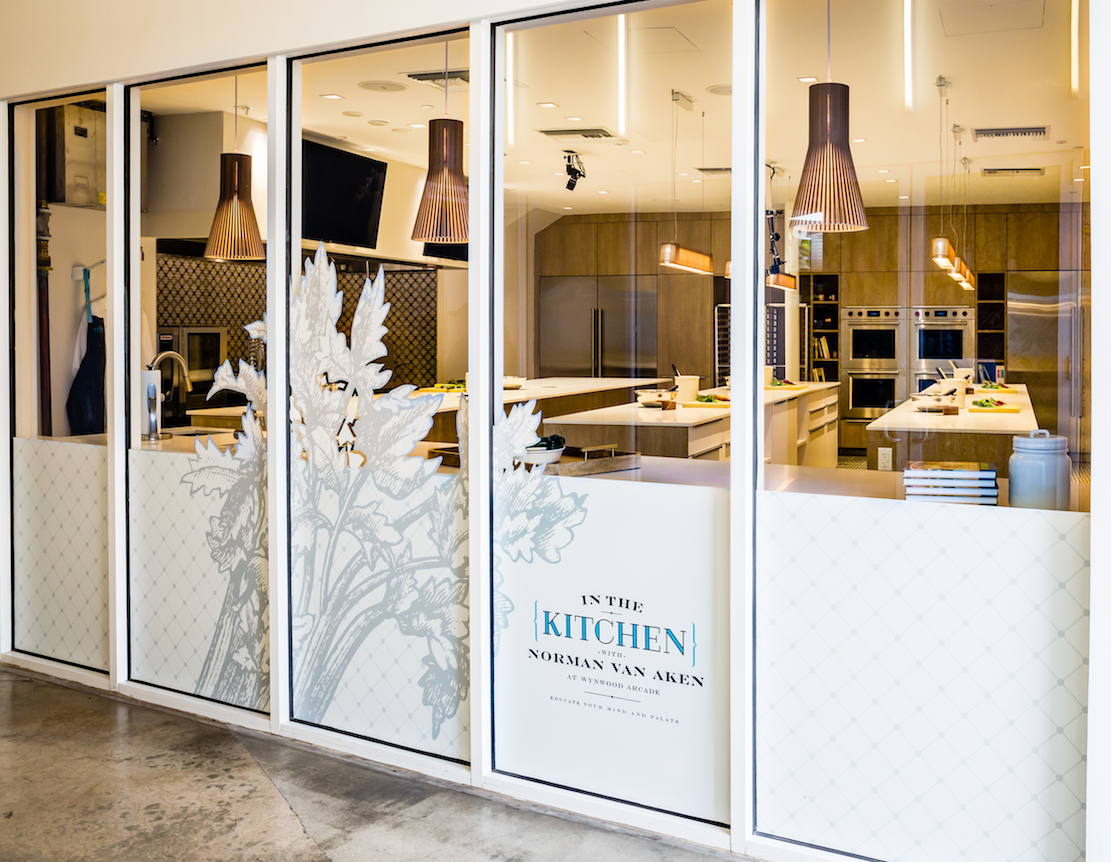 happening
on the plate, and eliminating at least one
ingredient wouldn’t hurt a bit. But by
and large each ingredient does make itself
apparent beyond just looking good. Thus,
first-rate hamachi
is subtly enhanced by a mango aguachile
of lime and chile peppers, Sichuan cucumbers and a
Peruvian cream of black mint called huacatay. Chilled
royal red shrimp get a boost from tomatillo-green
apple salsa and smoked Japanese red caviar called
ikura.
happening
on the plate, and eliminating at least one
ingredient wouldn’t hurt a bit. But by
and large each ingredient does make itself
apparent beyond just looking good. Thus,
first-rate hamachi
is subtly enhanced by a mango aguachile
of lime and chile peppers, Sichuan cucumbers and a
Peruvian cream of black mint called huacatay. Chilled
royal red shrimp get a boost from tomatillo-green
apple salsa and smoked Japanese red caviar called
ikura.
One of the best and homiest
items is the creamy cracked conch chowder with
citrus-flavored saffron, star anise and coconut
milk, which is the essence of Florida flavors.
Asparagus huancaina
comes with smoked egg, crispy yuca, gem lettuce
and preserved citrus, while grilled papaya “al pastor”
is a marvelous mélange of foie gras, radicchio,
agave and pickled mustards seeds.
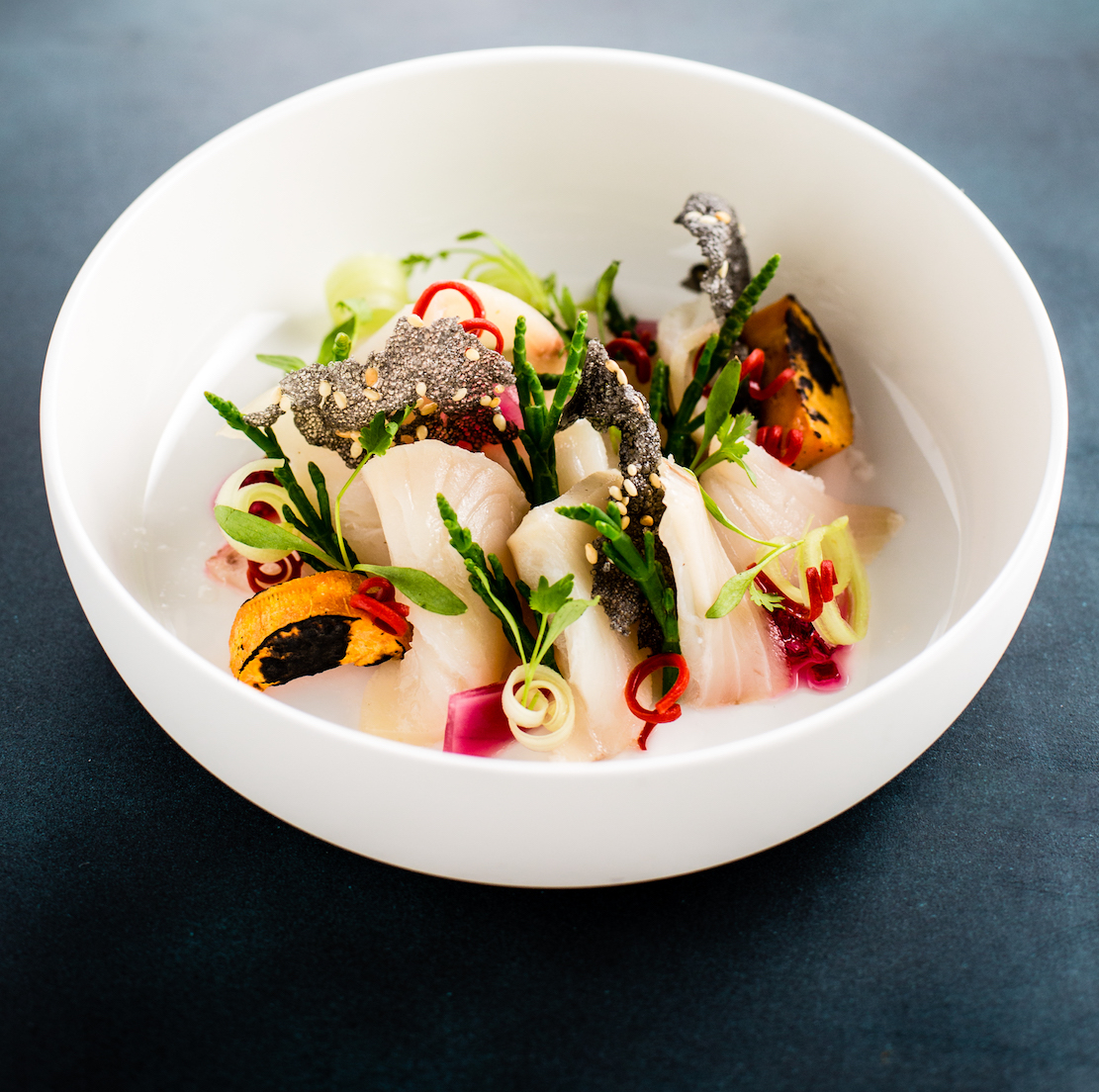 Sort of
simple—meaning it takes real skill to produce—is
the escabeche of spiced yellow jack with a coconut
creamed kale and smoked carrots. Florida
grouper swims with Cedar Key clams, salt-baked
turnips, grilled cucumbers, dill relish and Meyer
lemon for a very tangy dish. A chicken is poached
and served with grilled trumpet mushrooms,
artichoke gargoyle and tarragon cream.
Sort of
simple—meaning it takes real skill to produce—is
the escabeche of spiced yellow jack with a coconut
creamed kale and smoked carrots. Florida
grouper swims with Cedar Key clams, salt-baked
turnips, grilled cucumbers, dill relish and Meyer
lemon for a very tangy dish. A chicken is poached
and served with grilled trumpet mushrooms,
artichoke gargoyle and tarragon cream.
A
delicious rice dish, arroz
calasparra, made with a Spanish rice, came
with a black
garlic soffrito,
tender grilled squid, salt cod and roasted pepper
conserva you’d hope to find on a Caribbean
seashore. Barbecued cabbage with hoisin, yuzu kosho, a
crush of citrus zest, garlic, chile, and salt with
a decided acidic edge and cress salad was pleasant
enough, as 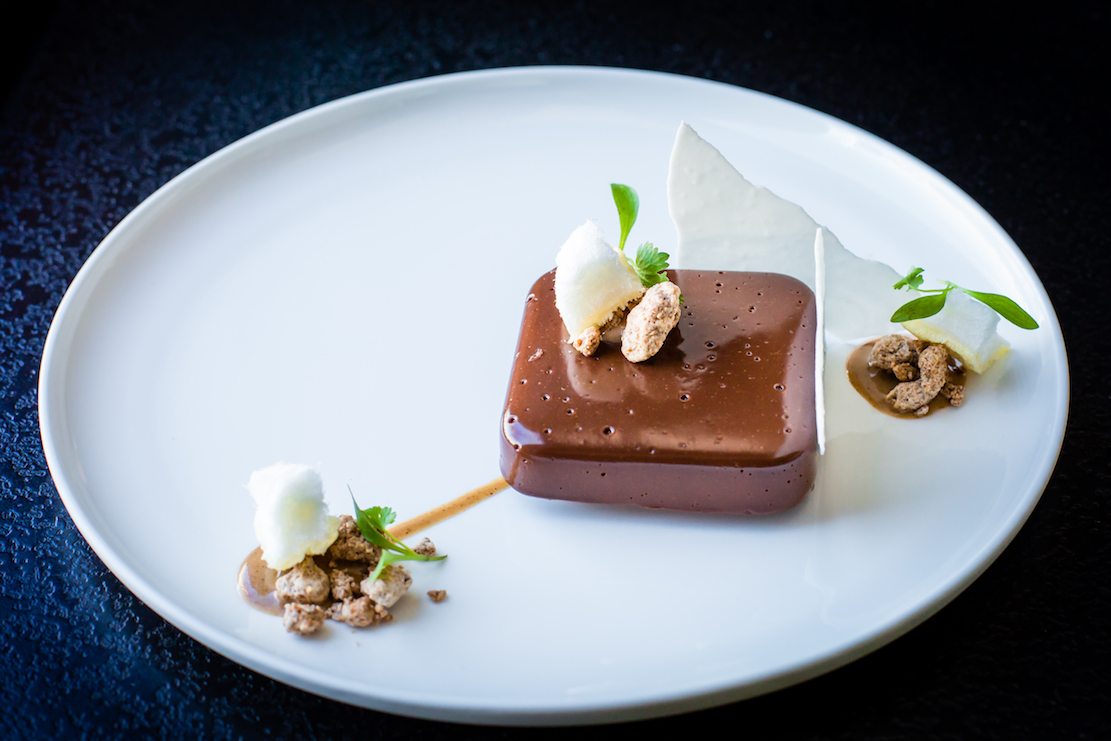 was
grilled saddle of lamb with roasted peaches, favas
and Sea Island red peas. Slow-roasted short rib was,
as expected, falling from the bone, with a
plantain miso,
preserved peppers, guasacaca
(form of Venezuelan guacamole) and aji Amarillo
jus—all
flavors that belong together to complement the
rich meat.
was
grilled saddle of lamb with roasted peaches, favas
and Sea Island red peas. Slow-roasted short rib was,
as expected, falling from the bone, with a
plantain miso,
preserved peppers, guasacaca
(form of Venezuelan guacamole) and aji Amarillo
jus—all
flavors that belong together to complement the
rich meat.
There is a plate of cheeses
($15)—none from Florida when I dined—but you’ll
want to see how Pastry Chef Mame Sow is right in
tune with Van Aken’s style in desserts like the
corn pudding a nicuatole with corn ice cream and
almond mole ($12) and Miami mango roulade with
lemongrass ganache, rice crisp and an olive oil
cake ($12). Three is not the last gasp of
Floribbean cuisine; it is the cutting edge of a
genre that van Aken helped create
Open Tues.-Sun. for dinner. Sun. for brunch.
By John Mariani
Interior photo by Eric Laignel
Food photos by Melissa Hom
448 West 16th Street (near Eighth Avenue)
212-620-0041
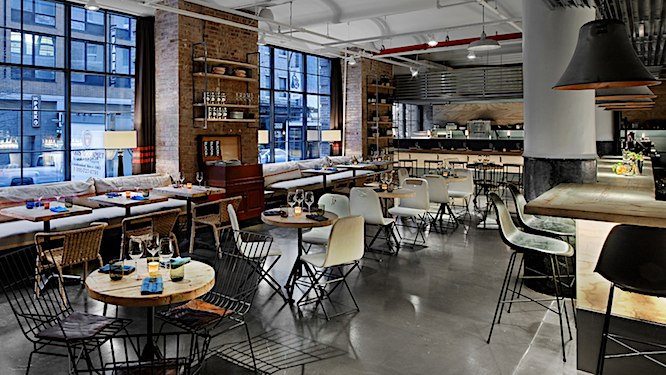
New
York’s Chelsea Market is a warren of food
shops and eateries where you can find
pretty much everything and anything. Just
wandering around it is half the fun.
Now a new place that is an offshoot of one
in NoMad has taken a space as both a
café and a furnishings-kitchen store named
Blackbarn.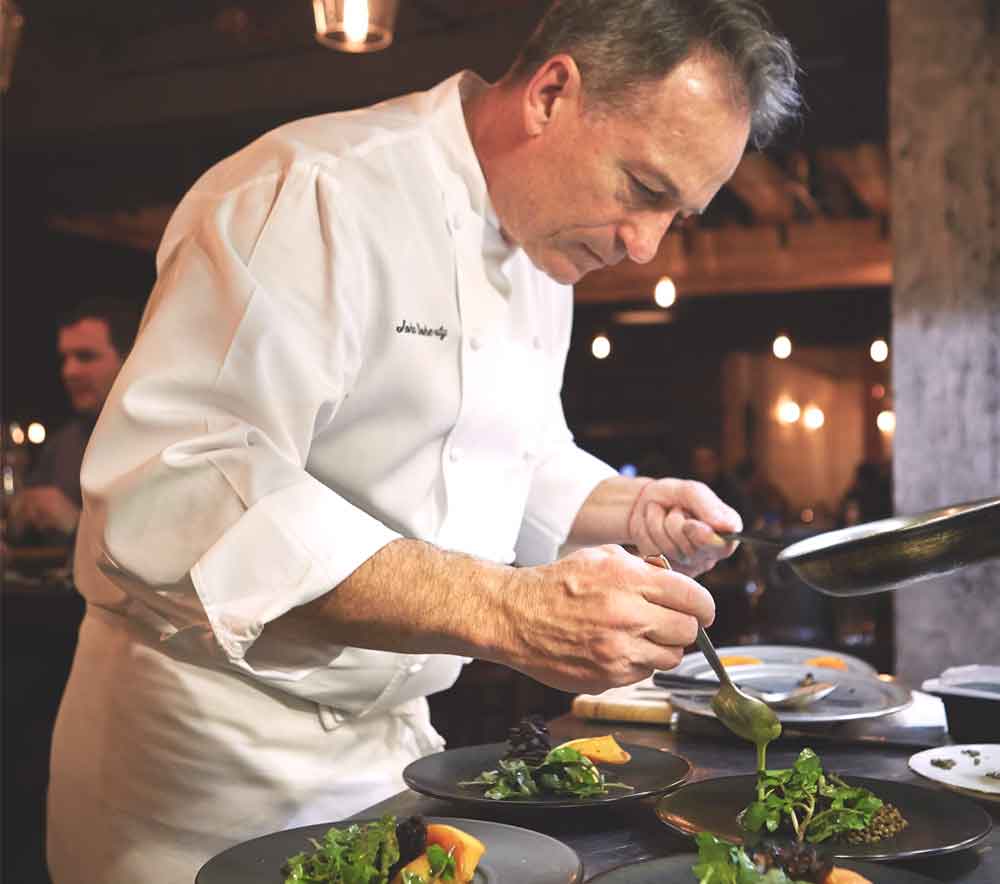
It’s
a very pretty place, brightly lighted, with
the goods arrayed in the entry room
(you can apparently buy many of the utensils,
glassware and linens used in the
café) and the spacious dining area overlooking
the street.
It’s casual in the most unaffected way,
although the pillowed banquettes’ backs are
set so far back from the table that
you have to slouch down on them like a pouty
child for back support. The wicker
chairs are quite comfortable, the noise level
moderate, the lighting buoyant
and there’s a counter at the open kitchen.
Chef-owner
John Doherty (right), who looks a lot like
either a young Tommy Lee Jones or the main
character actor in "Bette Call Saul," has been
a pro in the New York restaurant business
since the late
1980s, mainly as the long-running executive
chef overseeing all the food
service at the Waldorf Astoria Hotel,
beginning at the age of 19 and becoming
executive chef at 27. (Oh, the
stories he could tell!) He left that job a
decade ago and two years ago opened
the first Blackbarn on East 26th, a much
larger, much louder restaurant than
the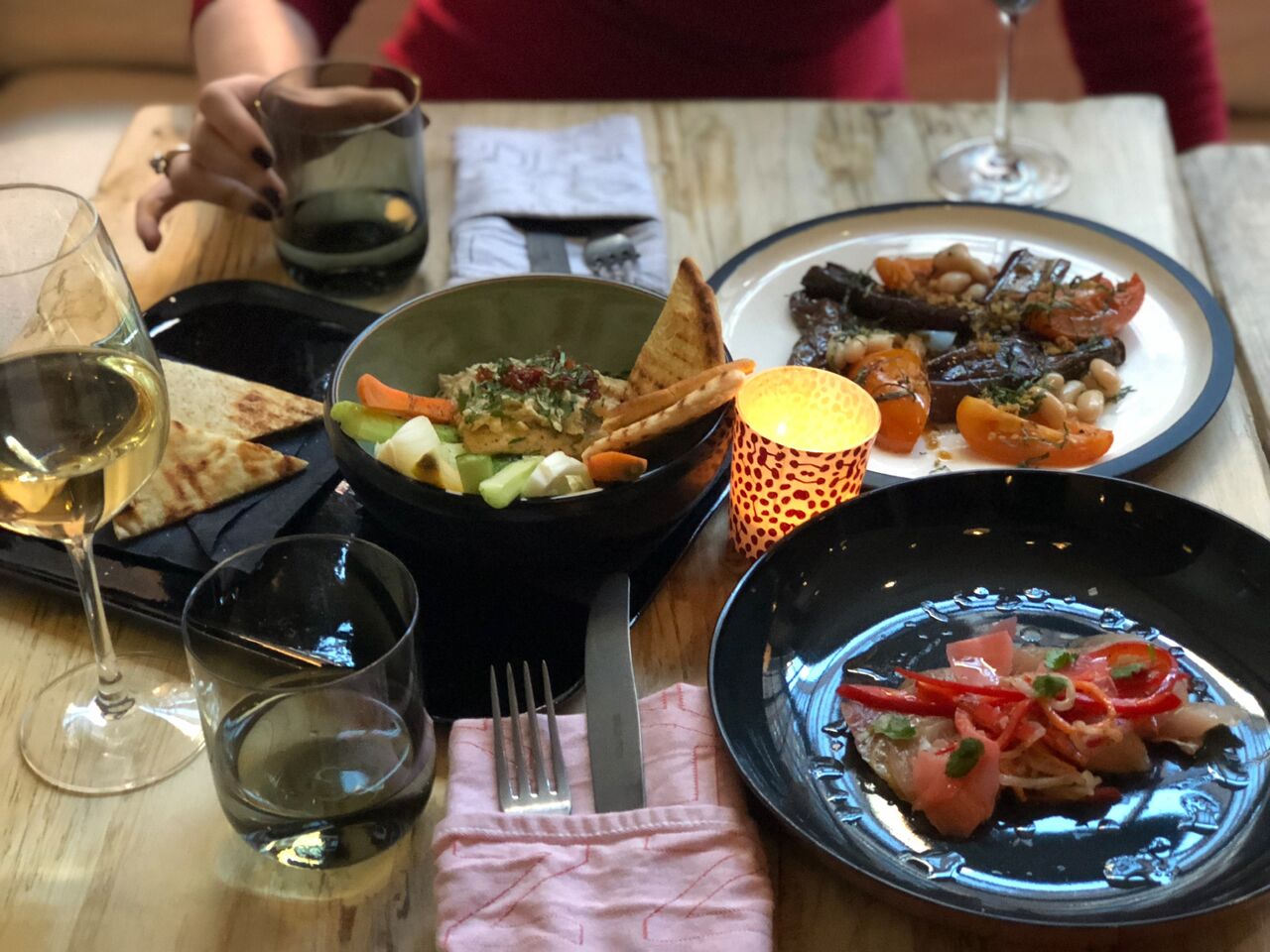 Café,
with a longer menu. At
the new branch, opened last December, Doherty
has re-fashioned the menu along
the idea of “healthy eating,” a moniker that
makes me wince, simply because I
don’t know of any foods that are un-healthy
if
consumed in reasonable amounts.
Café,
with a longer menu. At
the new branch, opened last December, Doherty
has re-fashioned the menu along
the idea of “healthy eating,” a moniker that
makes me wince, simply because I
don’t know of any foods that are un-healthy
if
consumed in reasonable amounts.
Nevertheless,
Blackbarn’s menu is heavily dependent on
vegetables and grains, with most of
the proteins saved for the main courses. The
results, I’m happy to report, are
impressive on every level.
Let’s
pretend
it is a vegetarian restaurant for a moment, in
which case those so inclined
to such a diet will be as thrilled as I was by
Blackbarn’s mushroom toast
spread with Robiola cheese, Taleggio,
Parmigiano and watercress ($15), and the
smoked eggplant hummus with roasted
vegetables, fried plantain and gremolata
($16). The charred Brussels
sprouts salad with apple butter, roasted red
onion, apple and jalapeño chutney
($16) was a big hit at my table of four, as
was a  stack
of fat Portobello
mushrooms atop a polenta cake with crispy
kale, roasted carrots and frisée
lettuce ($17).
stack
of fat Portobello
mushrooms atop a polenta cake with crispy
kale, roasted carrots and frisée
lettuce ($17).
Doherty
adds crunch and creaminess, smoke and
sweetness to most everything, so the
pan-roasted artichoke hearts with hen of the
woods mushrooms, eggplant hummus
and tahini-lemon dressing ($17) marry well
together in a very hearty dish. The
white pizza with truffle oil, porcini and
sweet caramelized onions
($18) is something the whole table will gobble
up fast.
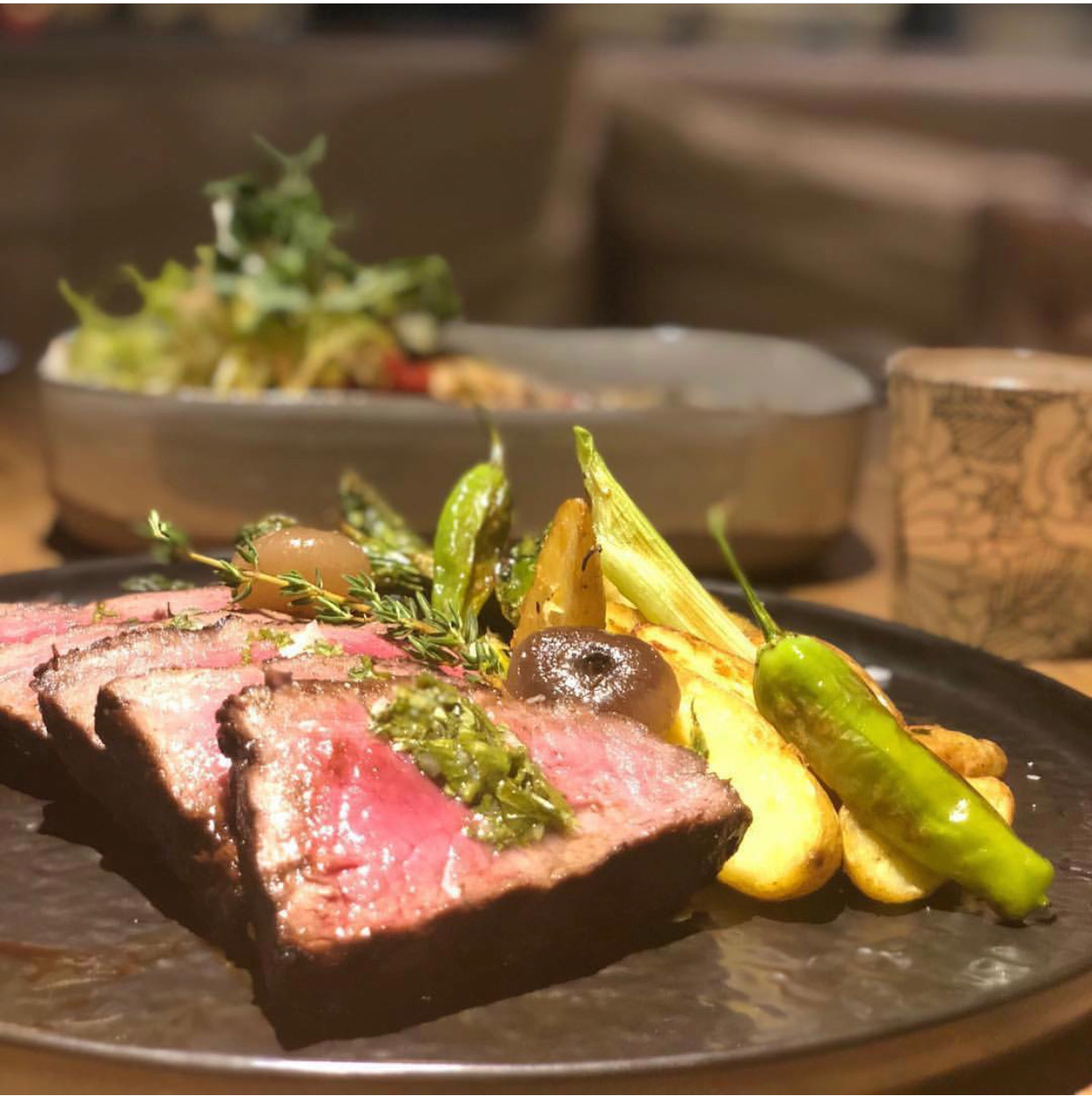 All
portions
are generous, with main courses even more so,
from Spanish octopus
with a black bean puree, zucchini, a touch of
chili and gremolata ($19). For the
decidedly non-vegetarian there is a hefty
New York strip streak doused with garlic and
served with asparagus, buttery
fingerling potatoes, baby onions and an
assertive salsa verde ($25). It’s like a
more flavorful version of carnitas
and remarkably modest in price.
Only a chicken Milanese with arugula, green
beans, asparagus and balsamic dash
($20) was run-of-the-mill.
All
portions
are generous, with main courses even more so,
from Spanish octopus
with a black bean puree, zucchini, a touch of
chili and gremolata ($19). For the
decidedly non-vegetarian there is a hefty
New York strip streak doused with garlic and
served with asparagus, buttery
fingerling potatoes, baby onions and an
assertive salsa verde ($25). It’s like a
more flavorful version of carnitas
and remarkably modest in price.
Only a chicken Milanese with arugula, green
beans, asparagus and balsamic dash
($20) was run-of-the-mill.
All
the desserts ($9) we tried were homey and
good, including chocolate crèmeux
with rich vanilla mousse (right);
almond cake with an autumn cherry compote;
forbidden
black rice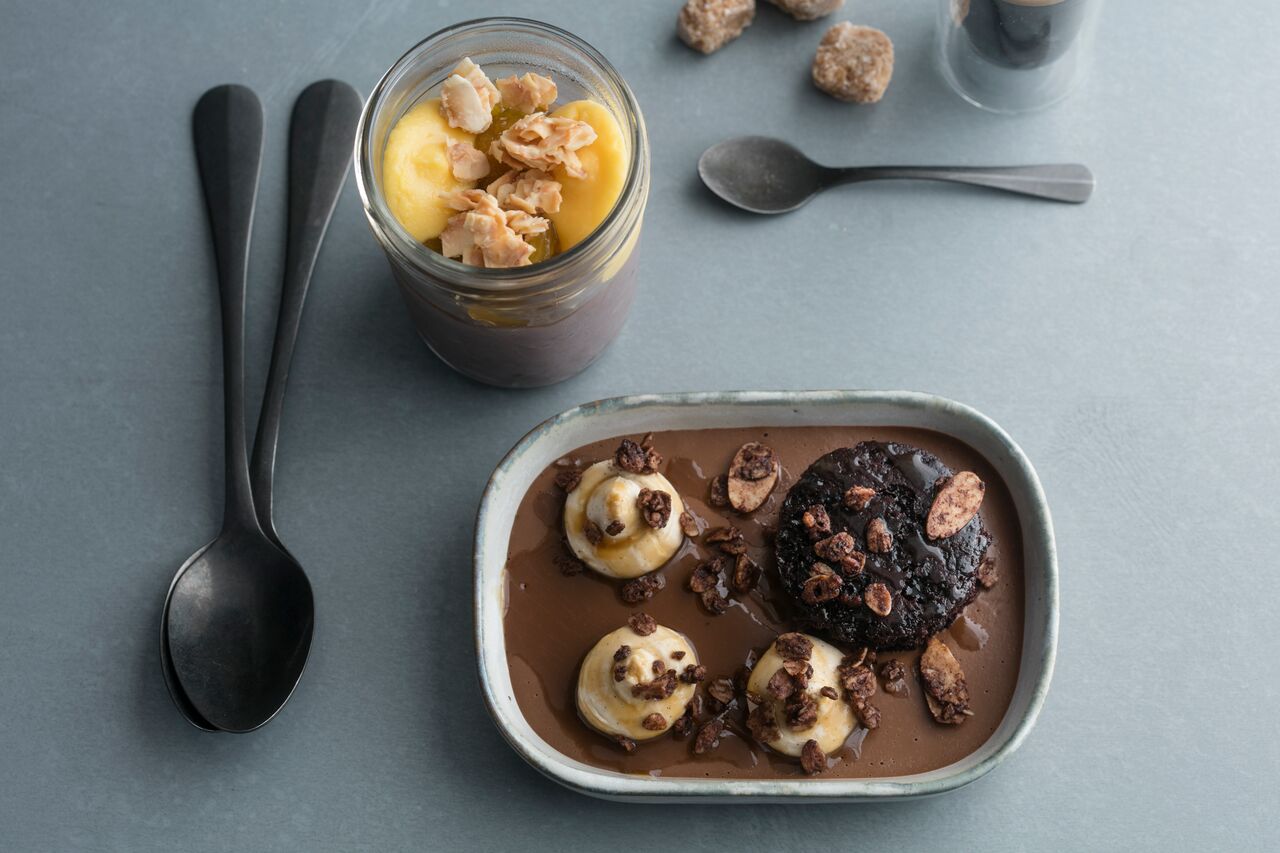 pudding with
passion fruit mousse and pineapple compote;
and a
terrific rum-laced, butterscotch-lavished
bread pudding with vanilla ice cream
and toffee sauce.
pudding with
passion fruit mousse and pineapple compote;
and a
terrific rum-laced, butterscotch-lavished
bread pudding with vanilla ice cream
and toffee sauce.
Blackbarn’s
wine list is disappointingly limited both in
scope and labels, but the prices,
averaging about $64 a bottle, are welcome
indeed.
Blackbarn
Café
is trying hard for all the best reasons to be
a very good, very
economical, very comfortable restaurant, and
even if sticking little “GF”
(gluten-free), “VEG” (vegetarian) and “V”
(vegan) symbols next to each dish may
be a little too “PC” for the omnivore, just
ignore them and have a wonderful
night out in Chelsea. You
may even
take home some forks and knives or place mats
on your way out.
Open
daily from 11 AM-9 PM.
❖❖❖
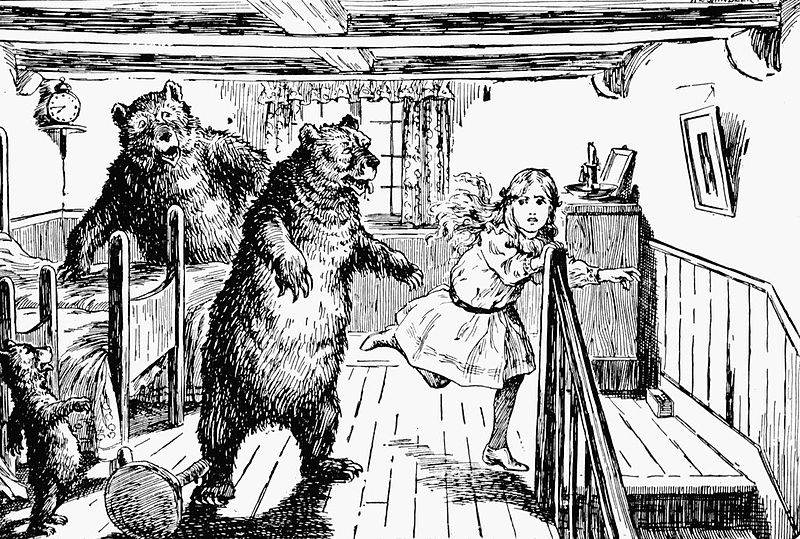 THE
GOLDILOCKS DILEMMA
THE
GOLDILOCKS DILEMMAWhat’s Too Hot, Too Cold, Just Right for Wine
By John Mariani
I have drunk enough 80
degree red wines in
overheated apartments and enough ice cold,
headache-inducing white wines to
know that many people’s idea of the right
temperature for a wine is woefully
misguided.
They go wrong in
swallowing the shibboleth that red wines should be
served at room temperature
and white wines stuck in an ice bucket for an
hour. Wines at those extremes
will be robbed of their flavors 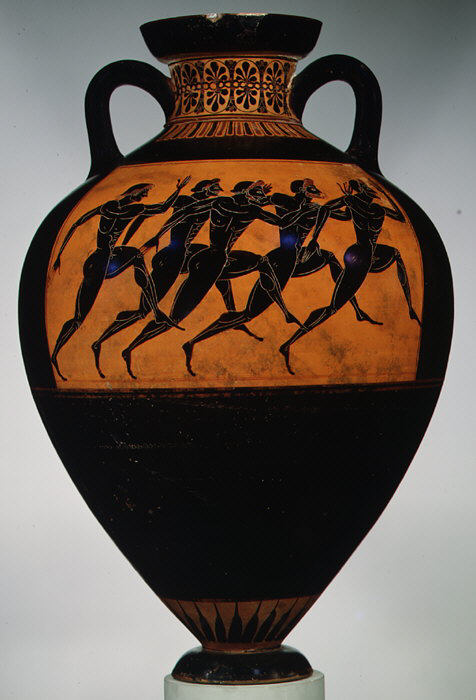 and
nuances.
and
nuances.
Like Goldilocks’s porridge,
wines have an
optimal temperature based on common sense and a
long history. Ever since man
began making wine, about 7,000 years ago, he has
looked for ways to preserve
its flavor and soundness for as long as possible.
Nomadic desert people like
the Israelites drank new, unaged wine carried in
animal skins. And, since
intense heat is wine’s enemy, Mediterranean people
aged their wine in thick
pottery jugs called amphoras (right).
Later, wines were stored below ground in cool
stone cellars with a constant temperature. To
serve red wines at “room
temperature” is ridiculous, if an air-conditioned
dining room is set at 75
degrees.
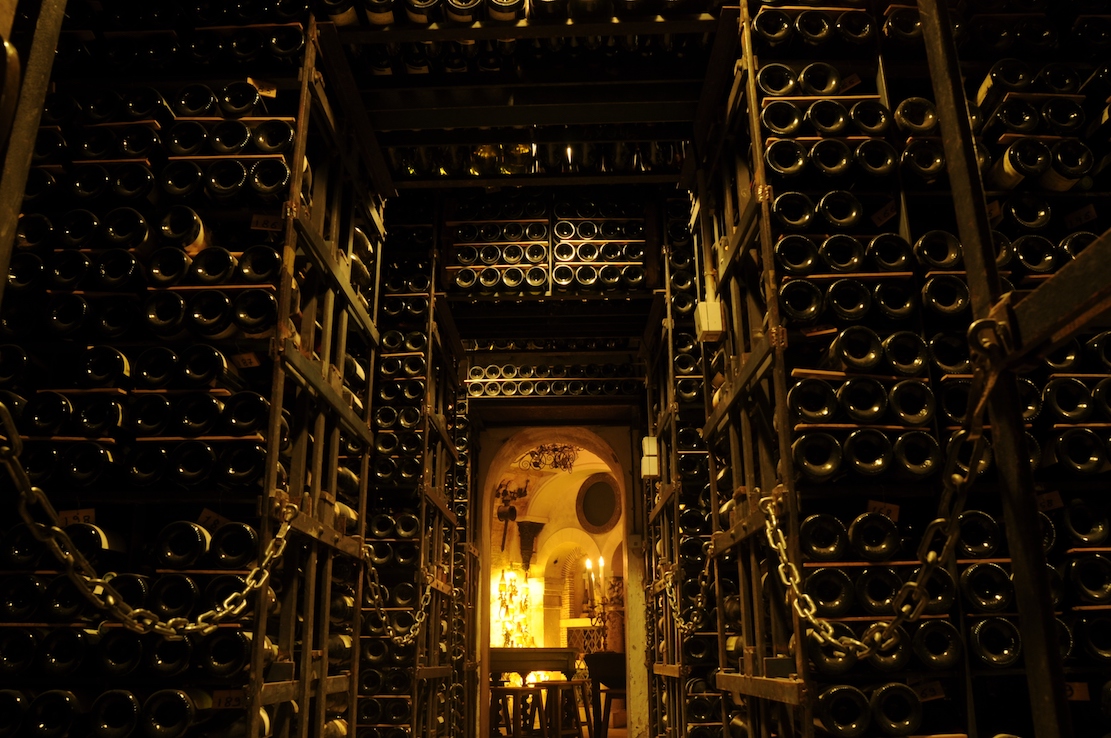 A
wine cellar in Paris (like La Tour d'Argent's, left),
London or Brussels is usually located in the
basement and year round remains at an ideal
temperature of about 55 degrees,
perfect for proper aging. An additional 10 degrees
over that will double the speed of the
aging process, without the benefit of slow,
proper aging. All finesse will disappear.
A
wine cellar in Paris (like La Tour d'Argent's, left),
London or Brussels is usually located in the
basement and year round remains at an ideal
temperature of about 55 degrees,
perfect for proper aging. An additional 10 degrees
over that will double the speed of the
aging process, without the benefit of slow,
proper aging. All finesse will disappear.
At many
restaurants wines
are stored in a temperature-controlled wine
cellar; when a wine is ordered, it
is brought up to the dining room: pinot noir is
served at 58-60 degrees;
cabernet sauvignon and merlot at 65 degrees; an
oaky California Chablis or
chardonnay will be chilled in an ice bucket to 50;
a white wine with less oak,
closer to 45 degrees. Champagne and sparkling wine
will be poured at 40
degrees.
You
need not worry too much if your glass of rosé
enjoyed poolside, or out of an
ice chest at the beach, isn’t at an ideal
temperature, but well-aged red and
white wines need a good deal more care, especially
if you’re bidding on rare
wines at auction.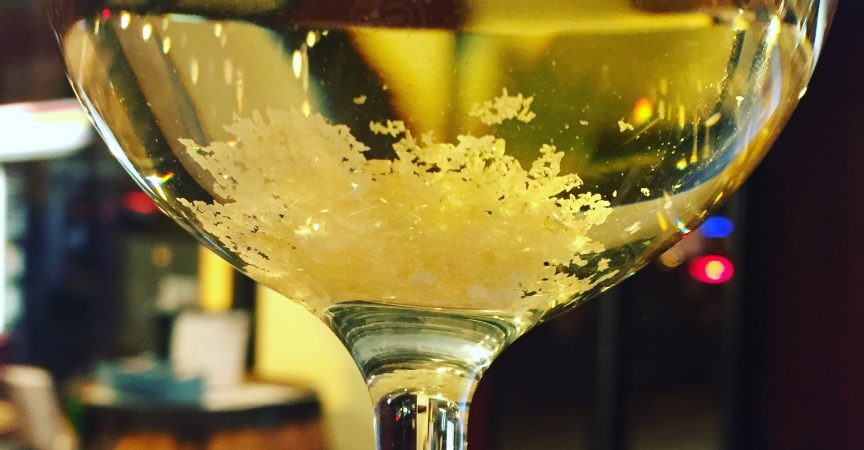
Red
wines age faster at higher temperatures but may
develop chemical compounds that
give the wines flabby, cooked or jam-like flavors,
while white wines near
freezing develop high deposits of white tartrates
(right),
harmless and tasteless but
wholly unappealing in a wine bottle.
Upscale
restaurants usually have some kind of refrigerated
wine units—many proudly
display them, with hundreds of bottles arrayed—but
restaurants with thousands
of bottles often keep them in storage houses.
Sommeliers will often insist that many
Americans still complain their
white wines are too warm. Unfortunately, some
guests want their white wine ice
cold. I feel more comfortable with whites at 50
degrees, although Champagne is
best at 40.
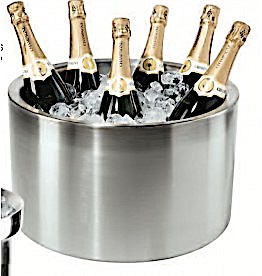 If
a restaurant serves its red
wine too warm, it is a telltale sign of negligence
and improper storage. If so,
ask the captain or waiter to stick the bottle in
an ice bucket for five
minutes.
If
a restaurant serves its red
wine too warm, it is a telltale sign of negligence
and improper storage. If so,
ask the captain or waiter to stick the bottle in
an ice bucket for five
minutes.
So,
too, white wines served from a dripping ice bucket
will be bone-chillingly cold
after 30 minutes, so ask them to take it out and
put it on the table.
Assuming
most people don’t have temperature-controlled
cellars, the cost
of converting one can be either nominal or
extravagant. In my house, the
cellar’s natural temperature never gets above 75
degrees in summer or below 55
in winter, which is fine for most bottles; my
expensive, long-aging wines are
kept in a refrigerated 50-bottle unit.
❖❖❖
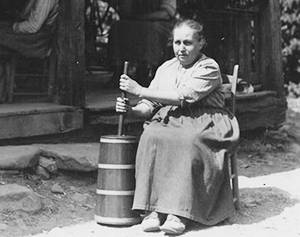
HYPER-DUMB
“It must really annoy
the owners of The White Bull, a new Decatur restaurant,
when other spots call themselves hyper-local. These guys
infuse Georgia ingredients into everything they serve,
from the butter (made with Sweetgrass Dairy cream) to
the pasta (milled in-house with Georgia red wheat) to
the green goddess dressing (prepared with local
herbs).”—Allison Weiss Entrekin, “The 22 Best
Restaurants in Atlanta,” CondeNast Traveler (Aug 2018).
THEIR NEXT RESTAURANT IS GOING
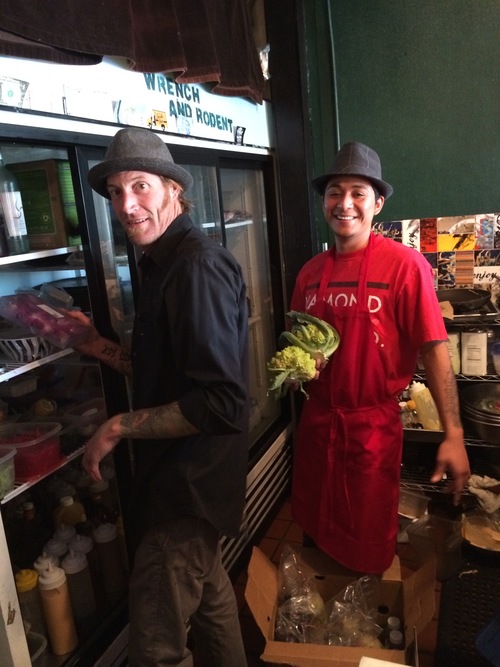
TO BE CALLED NUTS AND MAGGOTS
❖❖❖
Wine
Column Sponsored by Banfi Vintners
SANGIOVESE
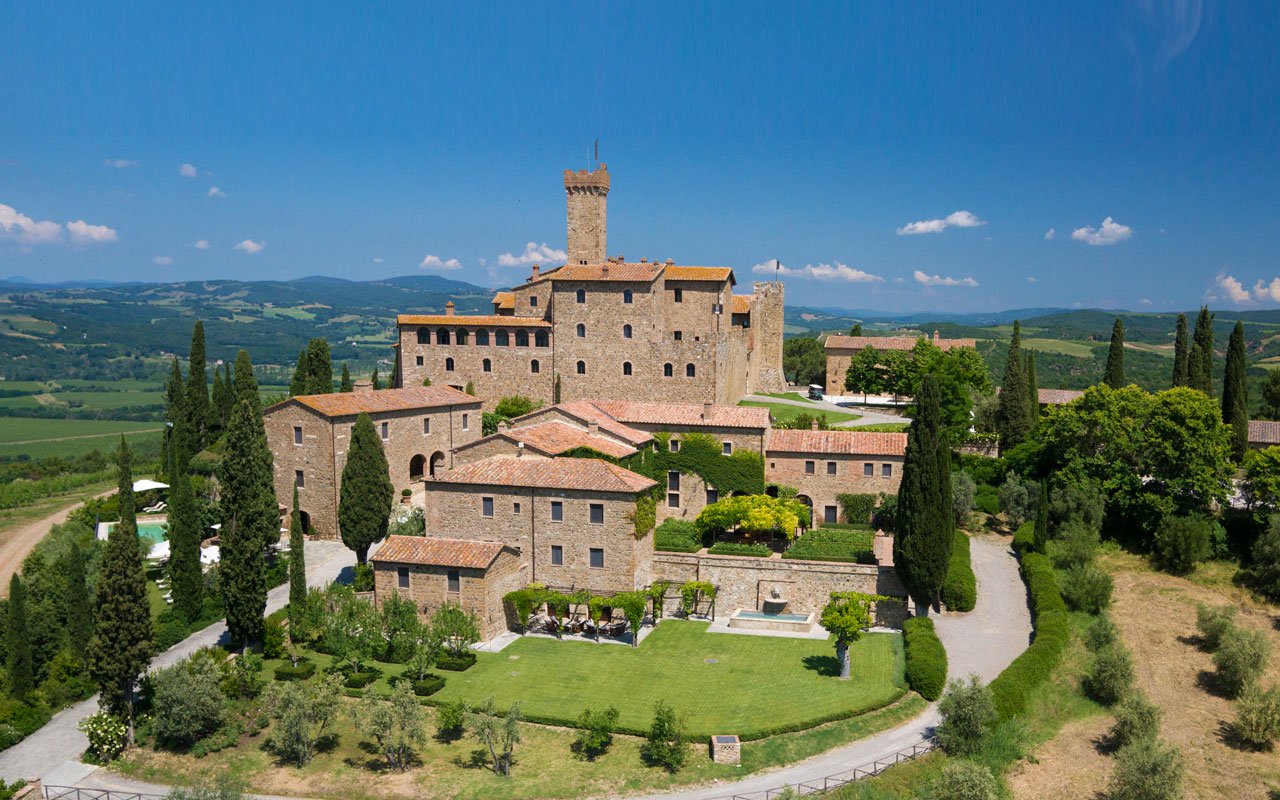 Wine is a joy year-round but
in cooler weather one
grape varietal has really taken center stage in
my daily activities – that most Italian of
grapes, Sangiovese, and its ultimate expression
– Brunello di Montalcino.
Wine is a joy year-round but
in cooler weather one
grape varietal has really taken center stage in
my daily activities – that most Italian of
grapes, Sangiovese, and its ultimate expression
– Brunello di Montalcino.
From mid-September through mid-October,
the Sangiovese grown for our various styles of red
wines are be harvested, culminating with the top
selection for Brunello di Montalcino.
Second, cooler weather here means
it is time to start enjoying more red wines and
especially Sangiovese based wines. That
includes Banfi’s cru of Brunello, Poggio alle Mura,
literally the cream of the crop of our Sangiovese
vineyards. Alongside our Poggio alle Mura Brunello di
Montalcino, this year we introduced two more wines
from the cru Poggio alle Mura – a Rosso di Montalcino
and a Riserva of Brunello. Rosso is sort of like the
younger brother of Brunello, also made from 100%
Sangiovese grapes but usually a selection from younger
vines and the wine is aged only two years compared to
the four required for Brunello. The
Riserva, on the other hand, is an even more selective
harvest of Sangiovese, and ages for an additional year
before release.
What is so special about this cru
Poggio alle Mura?
Well, it is the result our over 30 years of
ongoing research at my family’s vineyard estate,
Castello Banfi.
When we first began planting our vines there in
the late 1970s studies from the University of Bordeaux
indicated which strains of many varietals we should
plant, based on the soil type and microclimate of each
vineyard. But
when it came to the region’s native Sangiovese, there
was only local lore, no scientific research. So we took
it upon ourselves to figure out this vine, and set off
on three decades of incredibly detailed research.
We started
with 600 apparent variations on Sangiovese, because it
is so susceptible to variations in weather and soil,
and narrowed that down to 160 truly genetically
different clones.
We planted a vineyard with two rows of each
type, made wine from each of them, and charted the
differences – remember, you only get one chance a year
to make wine, so this took time.
It took about ten years to get some
concrete results, though we continue to experiment
today and always will – you never stop learning in
science and nature!
Once we determined which were the best,
complementary clones that could be planted together to
make the best Brunello, we chose to plant them in what
we determined to be the optimal vineyard sites. Coincidentally,
the best soils and climate conditions are in the
slopes surrounding the medieval fortress today known
as Castello Banfi, known since Etruscan times as
Poggio alle Mura – the walled hilltop. Hence the
name of our most special “cru” of Brunello,
representing a synthesis between tradition and
innovation.
Though the focus of this study was
our Brunello, all of our Sangiovese-based wines,
including the super Tuscans SummuS, Cum Laude, and
Centine, benefitted from this work. And that’s
the third reason for celebrating Sangiovese this
month, for the range of wonderful reds that usher us
into autumn! One
wine in particular was inspired by our research – the
BelnerO, a Sangiovese dominant blend with what I like
to call a kiss of Cabernet and a whisper of Merlot. We grow the
grapes a little differently for BelnerO than for
Brunello, make the wine with less oak aging and
released it earlier from the winery, providing a
counterpoint to Brunello and a lovely terroir-driven
wine in its own right.
If you
know Italians, you know that by nature we are
multi-faceted, varying in mood, and always passionate. As a
nation, we span from the hot sunny beaches of Sicily
near the African coast to the rugged mountains and
Alpine ski slopes of Trentino-Alto Adige in the north. Sangiovese
is grown in almost all of Italy’s regions and reflects
the unique nature of each; it is most famous
(rightfully so) in Tuscany, yet even there it reflects
the nuances of each hilltop, valley and subzone. It has
something a little different to say in Brunello than
Chianti, Morellino than Vino Nobile di Montepulciano,
Rosso di Montalcino than Super Tuscan blends.
Here is a smattering of
Sangiovese-based wines that you may wish to get to
know better, reflecting a spectrum that appeals to
every occasion, every taste, and every budget. We can
assure you that the conversation will never become
boring. 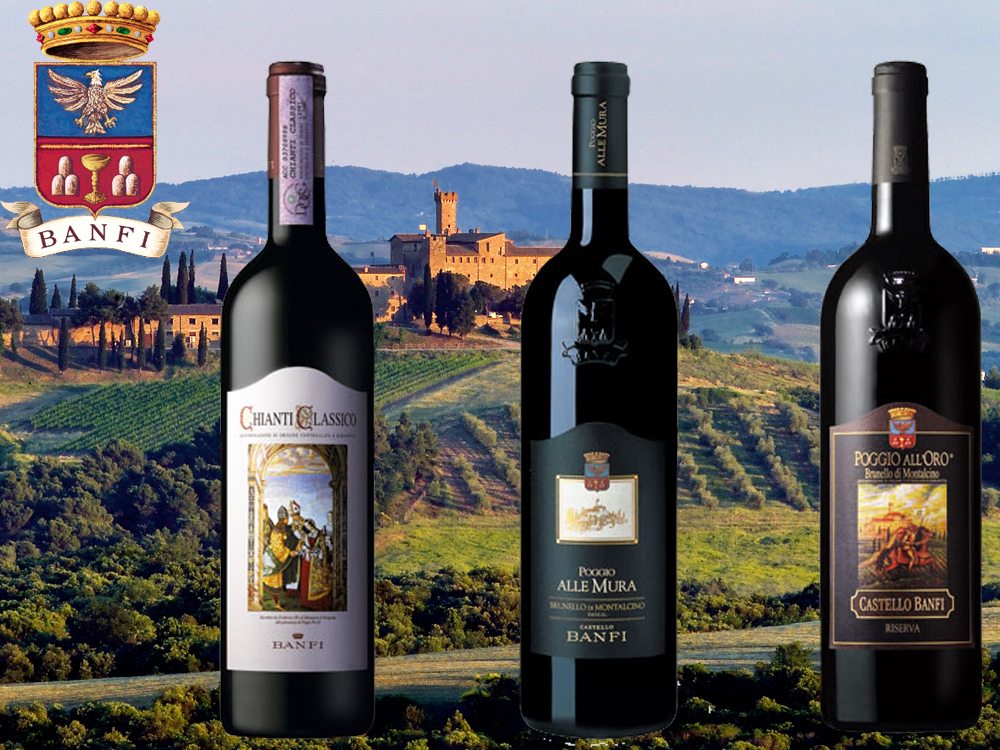
Recommendations for Celebrating
Sangiovese
BelnerO Proprietor’s Reserve Sangiovese
– A refined
cuvée of noble red grapes perfected by our pioneering
clonal research. This dark beauty, BelnerO, is
produced at our innovative winery, chosen 11
consecutive years as Italy’s Premier Vineyard Estate.
Fermented in our patented temperature controlled
French oak and aged approximately 2 additional years.
Unfiltered, and Nitrogen bottled to minimize sulfites.
Castello Banfi Brunello di Montalcino –
Rich, round, velvety and intensely
aromatic, with flavor hints of licorice, cherry, and
spices. Brunello di Montalcino possesses an intense
ruby-red color, and a depth, complexity and opulence
that is softened by an elegant, lingering aftertaste.
Unfiltered after 1998 vintage.
Castello Banfi Rosso di Montalcino – Brunello's "younger brother," produced
from select Sangiovese grapes and aged in barrique for
10 to 12 months. Deep ruby-red, elegant, vibrant,
well-balanced and stylish with a dry velvety
finish.
Poggio all’Oro Brunello di Montalcino
Riserva – A single vineyard selection of our most
historically outstanding Sangiovese, aged five years
before release, the additional year more than that
required of Brunello including 6 months in barrel and
6 months more in bottle to grant its “Riserva”
designation. Incredible
elegance and harmony. Intense with lots of fruit and
subtle wood influence. Round, complete, well balanced
with hints of chocolate and berries. Unfiltered after
1998.
Poggio alle Mura – The first tangible result of years of
intensive clonal research on Montalcino’s native
Sangiovese grape.
Estate bottled from the splendidly sun drenched
vineyards surrounding the medieval Castello from which
it takes its name.
The Brunello
di Montalcino is seductive, silky and smoky. Deep ruby
in color with an expressive bouquet of violets, fruits
and berries as well as cigar box, cedar and exotic
spices. The Rosso
di Montalcino is also intense ruby red. The bouquet
is fresh and fruity with typical varietal notes of
cherry and blackberry, enriched by more complex hints
of licorice, tobacco and hazelnut. It is full
bodied, yet with a soft structure, and a surprisingly
long finish. The Poggio alle Mura Brunello di Montalcino
Riserva is deep ruby red with garnet
reflections and a rich, ample bouquet that hints of
prune jam, coffee, cacao and a light balsamic note. It is full
and powerful, with ripe and gentle tannins that make
it velvety and harmonious; this wine is supported by a
pleasing minerality that to me speaks soundly of that
special hillside in southern Montalcino.
SummuS – A wine of towering elegance, SummuS is an
extraordinary blend of Sangiovese which contributes
body; Cabernet Sauvignon for fruit and structure; and
Syrah for elegance, character and a fruity bouquet. An elegant,
complex and harmonious red wine.
Cum Laude – A complex and elegant red which graduated
“With Honors,” characterized by aromas of juicy
berries and fresh spices.
Centine – A Cuvee that is more than half
Sangiovese, the balanced consisting of equal parts of
Cabernet Sauvignon and Merlot. Vinified in
a firm, round style that easily accompanies a wide
range of dishes, this is a smooth and fragrantly
satisfying wine with international character, and a
perennial favorite at my own dinner table.
Banfi Chianti Superiore – The “Superiore” designation signifies
stricter government regulations regarding production
and aging requirements, as compared to regular
Chianti. An
intense ruby red wine with fruit forward aromas and
floral notes. This
is a round wine with well-balanced acidity and fruit.
Banfi Chianti Classico – An enduring classic: alluring
bouquet of black fruit and violets; rich flavors of
cherry and leather; supple tannins and good acidity
for dining.
Banfi Chianti Classico Riserva – Produced from select grapes grown in the
"Classico" region of Chianti, this dry, fruity and
well-balanced red has a full bouquet reminiscent of
violets.
Fonte alla Selva Chianti Classico – This is our newest entry into the Chianti
arena, coming from a 99 acre estate in Castellina, the
heart of the Chianti Classico region. The wine is
a captivating mauve red that smells of cherry, plum
and blackberry with hints of spice. It is
round, full and balanced with very good
acidity.
Col di Sasso – Sangiovese and Cabernet Sauvignon. Luscious,
complex and soft with persistent notes of fruit and
great Italian style structure.
Any of John Mariani's books below may be ordered from amazon.com.
 The Hound in Heaven
(21st Century Lion Books) is a novella, and
for anyone who loves dogs, Christmas, romance,
inspiration, even the supernatural, I hope you'll find
this to be a treasured favorite. The story
concerns how, after a New England teacher, his wife and
their two daughters adopt a stray puppy found in their
barn in northern Maine, their lives seem full of promise.
But when tragedy strikes, their wonderful dog Lazarus and
the spirit of Christmas are the only things that may bring
his master back from the edge of despair.
The Hound in Heaven
(21st Century Lion Books) is a novella, and
for anyone who loves dogs, Christmas, romance,
inspiration, even the supernatural, I hope you'll find
this to be a treasured favorite. The story
concerns how, after a New England teacher, his wife and
their two daughters adopt a stray puppy found in their
barn in northern Maine, their lives seem full of promise.
But when tragedy strikes, their wonderful dog Lazarus and
the spirit of Christmas are the only things that may bring
his master back from the edge of despair. WATCH THE VIDEO!
“What a huge surprise turn this story took! I was completely stunned! I truly enjoyed this book and its message.” – Actress Ali MacGraw
“He had me at Page One. The amount of heart, human insight, soul searching, and deft literary strength that John Mariani pours into this airtight novella is vertigo-inducing. Perhaps ‘wow’ would be the best comment.” – James Dalessandro, author of Bohemian Heart and 1906.
“John Mariani’s Hound in Heaven starts with a well-painted portrayal of an American family, along with the requisite dog. A surprise event flips the action of the novel and captures us for a voyage leading to a hopeful and heart-warming message. A page turning, one sitting read, it’s the perfect antidote for the winter and promotion of holiday celebration.” – Ann Pearlman, author of The Christmas Cookie Club and A Gift for my Sister.
“John Mariani’s concise, achingly beautiful novella pulls a literary rabbit out of a hat – a mash-up of the cosmic and the intimate, the tragic and the heart-warming – a Christmas tale for all ages, and all faiths. Read it to your children, read it to yourself… but read it. Early and often. Highly recommended.” – Jay Bonansinga, New York Times bestselling author of Pinkerton’s War, The Sinking of The Eastland, and The Walking Dead: The Road To Woodbury.
“Amazing things happen when you open your heart to an animal. The Hound in Heaven delivers a powerful story of healing that is forged in the spiritual relationship between a man and his best friend. The book brings a message of hope that can enrich our images of family, love, and loss.” – Dr. Barbara Royal, author of The Royal Treatment.
 |
The Encyclopedia of American Food and Drink by John F. Mariani (Bloomsbury USA, $35) Modesty forbids me to praise my own new book, but let me proudly say that it is an extensive revision of the 4th edition that appeared more than a decade ago, before locavores, molecular cuisine, modernist cuisine, the Food Network and so much more, now included. Word origins have been completely updated, as have per capita consumption and production stats. Most important, for the first time since publication in the 1980s, the book includes more than 100 biographies of Americans who have changed the way we cook, eat and drink -- from Fannie Farmer and Julia Child to Robert Mondavi and Thomas Keller. "This book is amazing! It has entries for everything from `abalone' to `zwieback,' plus more than 500 recipes for classic American dishes and drinks."--Devra First, The Boston Globe. "Much needed in any kitchen library."--Bon Appetit. |
"Eating Italian will never be the same after reading John Mariani's entertaining and savory gastronomical history of the cuisine of Italy and how it won over appetites worldwide. . . . This book is such a tasteful narrative that it will literally make you hungry for Italian food and arouse your appetite for gastronomical history."--Don Oldenburg, USA Today. "Italian
restaurants--some good, some glitzy--far
outnumber their French rivals. Many of
these establishments are zestfully described
in How Italian Food Conquered the World, an
entertaining and fact-filled chronicle by
food-and-wine correspondent John F.
Mariani."--Aram Bakshian Jr., Wall Street
Journal.
"Equal parts
history, sociology, gastronomy, and just
plain fun, How Italian Food Conquered the
World tells the captivating and delicious
story of the (let's face it) everybody's
favorite cuisine with clarity, verve and
more than one surprise."--Colman Andrews,
editorial director of The Daily
Meal.com. "A fantastic and fascinating
read, covering everything from the influence
of Venice's spice trade to the impact of
Italian immigrants in America and the
evolution of alta cucina. This book will
serve as a terrific resource to anyone
interested in the real story of Italian
food."--Mary Ann Esposito, host of PBS-TV's
Ciao
Italia. "John Mariani has written the
definitive history of how Italians won their
way into our hearts, minds, and
stomachs. It's a story of pleasure over
pomp and taste over technique."--Danny Meyer,
owner of NYC restaurants Union Square
Cafe, The Modern, and Maialino.
|
 |
 |
 |
 |
 |
 |
 |
 |
 Everett Potter's Travel Report:
Everett Potter's Travel Report: 
 Eating Las Vegas
JOHN CURTAS has been covering the Las Vegas
food and restaurant scene since 1995. He is
the co-author of EATING LAS VEGAS – The 50
Essential Restaurants (as well as
the author of the Eating Las Vegas web site: www.eatinglasvegas.
He can also be seen every Friday morning as
the “resident foodie” for Wake Up With the
Wagners on KSNV TV (NBC) Channel 3 in
Las Vegas.
Eating Las Vegas
JOHN CURTAS has been covering the Las Vegas
food and restaurant scene since 1995. He is
the co-author of EATING LAS VEGAS – The 50
Essential Restaurants (as well as
the author of the Eating Las Vegas web site: www.eatinglasvegas.
He can also be seen every Friday morning as
the “resident foodie” for Wake Up With the
Wagners on KSNV TV (NBC) Channel 3 in
Las Vegas.
MARIANI'S VIRTUAL GOURMET
NEWSLETTER is published weekly. Publisher: John Mariani. Editor: Walter Bagley. Contributing Writers: Christopher Mariani,
Robert Mariani, Misha Mariani, John A. Curtas, Gerry Dawes, Geoff Kalish,
and Brian Freedman. Contributing
Photographer: Galina Dargery. Technical
Advisor: Gerry
McLoughlin.
If you wish to subscribe to this
newsletter, please click here: http://www.johnmariani.com/subscribe/index.html
© copyright John Mariani 2017

